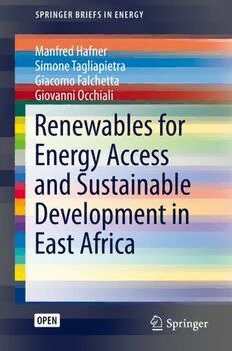
Renewables for Energy Access and Sustainable Development in East Africa PDF
Preview Renewables for Energy Access and Sustainable Development in East Africa
SPRINGER BRIEFS IN ENERGY Manfred Hafner Simone Tagliapietra Giacomo Falchetta Giovanni Occhiali Renewables for Energy Access and Sustainable Development in East Africa 123 SpringerBriefs in Energy Moreinformationaboutthisseriesathttp://www.springer.com/series/8903 (cid:129) (cid:129) Manfred Hafner Simone Tagliapietra (cid:129) Giacomo Falchetta Giovanni Occhiali Renewables for Energy Access and Sustainable Development in East Africa ManfredHafner SimoneTagliapietra FutureEnergyProgram FutureEnergyProgram FondazioneEniEnricoMattei FondazioneEniEnricoMattei Milano,Italy Milano,Italy GiacomoFalchetta GiovanniOcchiali FutureEnergyProgram FutureEnergyProgram FondazioneEniEnricoMattei FondazioneEniEnricoMattei Milano,Italy Milano,Italy ISSN2191-5520 ISSN2191-5539 (electronic) SpringerBriefsinEnergy ISBN978-3-030-11734-4 ISBN978-3-030-11735-1 (eBook) https://doi.org/10.1007/978-3-030-11735-1 LibraryofCongressControlNumber:2019931914 Thisbookisanopenaccesspublication. ©TheAuthor(s),underexclusivelicensetoSpringerNatureSwitzerlandAG2019 OpenAccessThisbookislicensedunderthetermsoftheCreativeCommonsAttribution4.0International License(http://creativecommons.org/licenses/by/4.0/),whichpermitsuse,sharing,adaptation,distribution andreproductioninanymediumorformat,aslongasyougiveappropriatecredittotheoriginalauthor(s)and thesource,providealinktotheCreativeCommonslicenseandindicateifchangesweremade. Theimagesorotherthirdpartymaterialinthisbookareincludedinthebook’sCreativeCommonslicense, unlessindicatedotherwiseinacreditlinetothematerial.Ifmaterialisnotincludedinthebook’sCreative Commonslicenseandyourintendeduseisnotpermittedbystatutoryregulationorexceedsthepermitteduse, youwillneedtoobtainpermissiondirectlyfromthecopyrightholder. Theuseofgeneraldescriptivenames,registerednames,trademarks,servicemarks,etc.inthispublication doesnotimply,evenintheabsenceofaspecificstatement,thatsuchnamesareexemptfromtherelevant protectivelawsandregulationsandthereforefreeforgeneraluse. Thepublisher,theauthors,andtheeditorsaresafetoassumethattheadviceandinformationinthisbook arebelievedtobetrueandaccurateatthedateofpublication.Neitherthepublishernortheauthorsorthe editorsgiveawarranty,expressorimplied,withrespecttothematerialcontainedhereinorforanyerrors oromissionsthatmayhavebeenmade.Thepublisherremainsneutralwithregardtojurisdictionalclaims inpublishedmapsandinstitutionalaffiliations. ThisSpringerimprintispublishedbytheregisteredcompanySpringerNatureSwitzerlandAG. Theregisteredcompanyaddressis:Gewerbestrasse11,6330Cham,Switzerland Foreword Imagine life with no electricity. No fridge with vaccines for a newborn child, nor important anaesthetics for the mother giving birth. No exposure to computers in school.Nomachinestoproduce.Andyetmorethanabillionpeoplelivewithout. Then consider the difficulty of the analyst wishing to study how to electrify a countryandsupplyenergytodriveitsdevelopment.Theyarefacedwithamountain ofatask.Dataislimited;modellingtoolsareexpensive. Pondertheplightofthepolicymakerwhoshouldmanagenationalresources,set market rules and engage with investors and development partners. The latter want hardauditableinformation.Inmanyinstancesthattypeofinformationsimplydoes not exist. Investment is therefore not made. Those without electricity stay without and,inturn,arelockedoutoftheopportunitiesthatmostofthereadersofthisbook willenjoy. In this book, the authors join the charge to help breach this deadlock—with a focusonEastAfrica.Theydosobymapping thehighpotentialsofrenewableand gasreservesintheregion,aswellasthecomplementaryroletheymayplay.Then,by taking advantage of scientific advances in open data and free open models, they deliver quantitative scenarios. These provide a powerful vision. Together with thought-leadinganalysistheauthorshelporientatethedebatearound—andpotential directions for—investment and development in electrification, gas and renewable energydeployment. Along the way they leave as a legacy transparent, reproducible, reconstructable data,toolsandinsight.Thisisauniqueandpowerfulcontribution. DivisionofEnergySystemsAnalysis(KTH-dESA) MarkHowells RoyalInstituteofTechnology Stockholm,Sweden v Acknowledgements Support from the Fondazione Eni Enrico Mattei (FEEM) in realising this book is gratefullyacknowledged.TheauthorsarealsothankfultotheKTHRoyalInstituteof Technology—DivisionofEnergySystemAnalysis(dESA)fororganisingthe2018 SummerSchoolonModellingToolsforSustainableDevelopment. vii About the Fondazione Eni Enrico Mattei (FEEM) TheFondazioneEniEnricoMattei(FEEM),foundedin1989,isanon-profit,policy- oriented, international research centre and a think tank producing high-quality, innovative, interdisciplinary and scientifically sound research on sustainable development. It contributestothe quality of decision-making inpublicand private spheresthroughanalyticalstudies,policyadvice,scientificdisseminationandhigh- leveleducation.Thankstoitsinternationalnetwork,FEEMintegratesitsresearchand disseminationactivitieswiththoseofthebestacademicinstitutionsandthinktanks aroundtheworld. ix ’ About FEEM s Future Energy Program (FEP) The Future Energy Program (previously called Energy Scenarios and Policy program) aims to carry out interdisciplinary, scientifically sound, prospective and policy-orientedappliedresearch,targetedatpoliticalandbusinessdecision-makers. This aim is achieved through an integrated quantitative and qualitative analysis of energy scenarios and policies. This innovative and interdisciplinary approach puts together the major factors driving the change in global energy dynamics (i.e. technological, economic, geopolitical, institutional and sociological aspects). FEPappliesthismethodologytoawiderangeofissues(energydemandandsupply, infrastructures, financing, market analyses, socio-economic impacts of energy policies). xi Contents 1 Introduction. . . . . .. . . . .. . . . .. . . . . .. . . . .. . . . . .. . . . .. . . . . . 1 2 EastAfrica:RegionalEnergyOutlook. . . . . . . . . . . . . . . . . . . . . . . . 9 3 Country-LevelAnalysis:PowerSector,EnergyResources, andPolicyContext.. . . . . . . . . . . . . . . . . . . . . . . . . . . . . . . . . . . . . . 19 4 ElectrificationScenarios. . . . .. . . . . .. . . . . .. . . . . .. . . . . .. . . . . . 49 5 ConditionsforREDeploymentandEnergyDevelopment. . . . . . . . . 73 6 REInteractionwithNGResources. . . . . . . . . . . . . . . . . . . . . . . . . . 117 7 ConclusionsandPolicyImplications. . . . . . . . . . . . . . . . . . . . . . . . . 123 AppendixA:AdditionalTablesandFigures. . . . . . . . . . . . . . . . . . . . . . 129 AppendixB:MethodologyandParametersoftheElectrification Analysis. . . .. . . . .. . . . . .. . . . . .. . . . . .. . . . .. . . . . .. . . . . .. . . . .. 145 xiii
